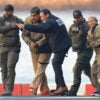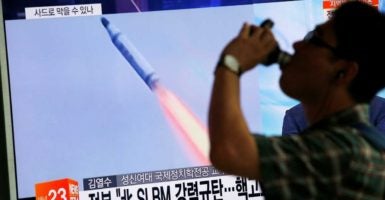North Korea conducted its most successful test launch of a submarine-launched ballistic missile on Tuesday. The missile traveled 500 kilometers (300 miles), a considerable improvement over the 30-km range of the previous launch, and landed within Japan’s air defense identification zone.
South Korean military officials report that North Korea used an unusual 500-km high trajectory so as not to penetrate the Japanese air defense zone further. If launched on a regular 150-km high trajectory, the submarine-launched missile might have traveled over 1,000 km.
After the unsuccessful missile test earlier this year, the South Korean ministry of defense assessed it would take North Korea three to four years before deploying a submarine ballistic missile force. However, after yesterday’s test, some South Korean military authorities warn deployment potentially could occur within a year.
South Korea does not currently have defenses against submarine-launched ballistic missiles. The SM-2 missile currently deployed on South Korean destroyers only provides protection against anti-ship missiles. South Korea has recently expressed interest in the U.S.-developed SM-3 or SM-6 ship-borne systems to provide anti-submarine launched missile defense.
Some experts are dismissive of a submarine-based ballistic missile threat based on the perception that North Korea’s old and noisy submarines would be easy to detect. However, in 2010, a North Korean submarine sank the South Korean naval corvette Cheonan in South Korean waters. In August 2015, 50 North Korean submarines—70 percent of the fleet—left port and disappeared despite allied monitoring efforts.
Despite post-Cheonan efforts, South Korean anti-submarine warfare capabilities remain an area of concern for allied military planners. A strong anti-submarine capability is not only critical for homeland defense but also for protecting sea lines of communication during a crisis on the Korean Peninsula. During a Korean conflict, the South Korean navy could have a critical mission to protect U.S. carrier groups deployed near the peninsula by engaging North Korean submarines.
Expanding Missile Threat
North Korean leader Kim Jong Un is pushing forward rapidly on both nuclear and missile fronts. In addition to submarine missile launches, this year he has successfully tested a nuclear weapon, an intercontinental ballistic missile, a road-mobile intermediate-range missile as well as medium- and short-range missiles, re-entry vehicle technology, a new solid-fuel rocket engine, and an improved liquid-fuel ICBM engine. During Kim’s four-year reign, Pyongyang has conducted 34 missile tests, more than twice as many as his father Kim Jong Il did in 17 years in office.
In June, North Korea successfully tested a Musudan intermediate-range missile, which led experts to conclude the regime currently has the ability to threaten U.S. bases in Guam, a critical node in allied plans for defending South Korea. Successful No Dong medium-range missile tests were conducted in July and August, accompanied by North Korean statements that they were practice drills for preemptive nuclear attacks on South Korea and U.S. forces based there.
A North Korean media-released photo showed the missile range would encompass all of South Korea, including the port of Busan where U.S. reinforcement forces would land. Adm. Bill Gortney, commander of North American Aerospace Defense Command, stated that North Korea is capable of putting a nuclear warhead on the No Dong medium-range ballistic missile that can reach all of South Korea and Japan.
In March, Kim Jong Un observed another missile launch simulating a nuclear missile attack on South Korean targets. The regime declared those launches were “a sea port of debarkation ballistic missile test [conducted] under the simulated conditions of exploding nuclear warheads from the preset altitude above targets in the ports under the enemy control where foreign aggressor forces are involved.”
In February, North Korea again used a Taepo Dong missile to put a satellite into orbit, the same technology needed to launch an ICBM nuclear warhead. Assessments indicate that the satellite was approximately 450 pounds, twice as heavy a payload as the previous successful satellite launch in Dec. 2012, and that the missile may have a range of 13,000 km, putting the entire continental United States within range.
Defending Allied Security
The accelerated pace of North Korean nuclear and missile tests reflect Kim’s intent to deploy a spectrum of missile systems of complementary ranges to threaten the U.S. and its allies with nuclear weapons. Kim affirmed at the National Party Congress in May—the first held in 36 years—that North Korea will never negotiate away its nuclear weapons.
The U.S. and South Korea should:
- Deploy the THAAD ballistic missile defense system. The Terminal High Altitude Area Defense, or THAAD, is more capable than any system that South Korea has or would have for decades to defend against North Korean land-based missiles.
- Refute fallacious Chinese arguments against THAAD. Beijing asserted that THAAD deployment would impinge on its security interests. However, a careful analysis of THAAD interceptor and radar capabilities and Chinese missile deployment sites reveal Chinese technical objections are disingenuous. Beijing’s true objective is preventing improvement in allied defensive capabilities and multilateral cooperation.
- Demonstrate THAAD radar is not a health threat. South Korean critics of THAAD deployment claim fears of radiation risks from the X-band radar, saying it would kill bees and irradiate melons. Independent South Korean measurements show the levels of electromagnetic waves emanating from the radar are at an intensity far safer than required by Korean law.
- Deploy sea-based ballistic missile defense against the submarine missile threat. The THAAD system is not designed to counter SLBM threats. The X-band radar can only detect missiles in an approximate 90-degree arc, which would be directed toward North Korea, not the waters surrounding the Korean Peninsula. Therefore, Washington and Seoul should discuss deployment of SM-3 or SM-6 missiles on South Korean naval ships.
- Augment allied anti-submarine warfare capabilities. North Korea’s apparent ability to evade allied submarine detection systems is worrisome. Washington should facilitate South Korean collection and analysis capabilities and linkage with U.S. naval intelligence. Seoul requires wide-area ocean-surveillance capability, for both coastal defense and blue-water operations.
North Korea continues its relentless quest to augment and refine its nuclear weapons arsenal and missile delivery capabilities. The international community should maintain a comprehensive effort of augmented sanctions for North Korea’s repeated violations of U.N. resolutions and international law.
But the U.S. and its allies must implement measures to defend themselves against the spectrum of North Korea’s military threats. Ballistic missile defense is an important part of the broader strategy of strong alliances, forward-deployed U.S. military forces in the Pacific, and devoting sufficient resources to the U.S. defense budget.






























